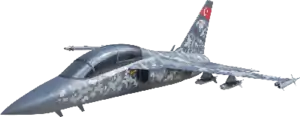TAI Hürjet
The TAI Hürjet is a proposed single-engine, tandem seat, supersonic advanced trainer and light combat aircraft, under development by Turkish Aerospace Industries (TAI).[1][2][3]
| Hürjet | |
|---|---|
 | |
| Hürjet artist conception | |
| Role | Advanced jet trainer, Lead-in fighter trainer/Light combat aircraft |
| National origin | Turkey |
| Manufacturer | Turkish Aerospace Industries |
| Status | Under development |
| Primary user | Turkish Air Force (intended) |
TAI intends that the design will replace the Northrop T-38 Talon in the jet trainer role and supplement the General Dynamics F-16 Fighting Falcon in the close air support and fighter training roles in Turkish Air Force service.[2]
The company also plans to pursue export orders for the design to countries looking to replace older trainer and ground attack aircraft.[1]
Design and development
.jpg.webp)
The project was started by TAI in August 2017 using its own financial resources. A mock-up was displayed at the 2018 Farnborough International Airshow.[2]
On 22 July 2018 the Turkish Under-secretariat for Defence Industries announced that the Turkish Air Force had signed an agreement with TAI, giving the project official status to move development forward.[2]
As of January 2020 the aircraft did not have an engine selected, although the Eurojet EJ200 and the General Electric F404-GE-102 were under consideration to the power the design.[3]
Capabilities are planned to include air-to-air refuelling, fly-by-wire with parameter limiting, built in auxiliary power unit, night vision goggle-compatible cockpit, head-up display and an integrated helmet display system.[2]
Specifications (projected)
Data from Manufacturer[1]
General characteristics
- Crew: one
- Capacity: one passenger
- Length: 13 m (42 ft 8 in)
- Wingspan: 9.8 m (32 ft 2 in)
- Height: 4.2 m (13 ft 9 in)
- Wing area: 24 m2 (260 sq ft)
- Powerplant: 1 × TBA , 85 kN (19,200 lbf) thrust turbofan, engine not yet selected
Performance
- Maximum speed: Mach 1.4
- Combat range: 2,592 km (1,611 mi, 1,400 nmi)
- Service ceiling: 13,716 m (45,000 ft)
- g limits: +8/-3 g
- Rate of climb: 180 m/s (35,000 ft/min)
See also
Aircraft of comparable role, configuration, and era
- AIDC T-5 Brave Eagle
- Alenia Aermacchi M-346 Master
- Boeing T-7 Red Hawk
- Hongdu JL-10
- KAI T-50 Golden Eagle
- Yakovlev Yak-130
References
- Turkish Aerospace Industries (2017). "Hürjet". tusas.com. Archived from the original on 3 March 2020. Retrieved 15 April 2020.
- Military Science and Intelligence (18 September 2018). "Hürjet Comes to Light in England". savunmahaber.com. Archived from the original on 26 April 2020. Retrieved 26 April 2020.
- C4 Defence (1 January 2020). "Hürjet'in Motorunda Rekabet Devam Ediyor (Competition Continues for Hürjet's Engine)". c4defence.com. Archived from the original on 19 May 2020. Retrieved 26 April 2020.